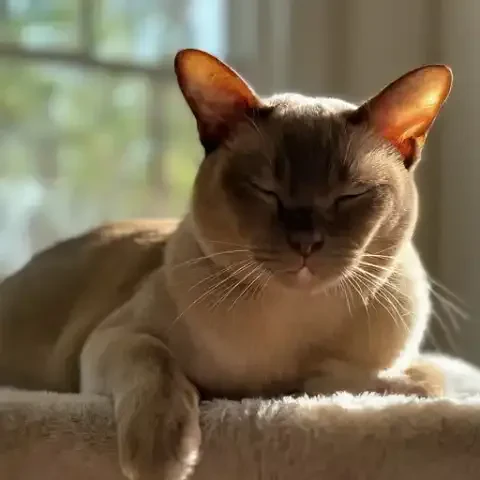The gentle nudge of a velvety paw, the rhythmic rumble of a contented purr, the quiet, unwavering presence in a sunbeam-drenched room. These are the subtle yet profound ways cats weave themselves into the fabric of our lives, and for children, this interspecies connection can be especially transformative. We often speak of the benefits of dog ownership for children, and rightly so. But a quieter, perhaps less heralded truth exists: the unique and powerful advantages that feline companionship brings to a child's world. For too long, misconceptions about cats – their supposed aloofness, their independent nature – have overshadowed the remarkable ways they enrich the lives of young people. This article aims to dispel those myths and illuminate the myriad ways cat ownership can become a cornerstone of a child's healthy development, impacting them emotionally, socially, cognitively, and even physically. From fostering deep empathy to providing a steadfast, non-judgmental friend, the benefits of welcoming a cat into a child's life are as purrfectly tailored to their needs as they are often overlooked. Let us delve into the heart of these benefits, exploring how the simple act of sharing life with a feline can unlock a wealth of growth and joy for children.
Perhaps one of the most fundamental gifts a cat offers a child is the profound sense of companionship. In a world that can sometimes feel overwhelming and isolating, a cat provides a constant, unwavering presence. Unlike busy parents or sometimes preoccupied siblings, a cat is always there, ready to listen – or perhaps more accurately, to simply be present, offering silent, comforting support. For children who are only children, or those who might lean towards introversion, this constant companionship can be especially invaluable. A cat becomes a confidante, a silent partner in playtime, a warm body curled up at the foot of the bed at night. They are never truly alone. Furthermore, the love a cat offers is often perceived by children as uniquely accepting and non-judgmental. A cat doesn't care about grades, social pressures, or perceived imperfections. They respond to gentle affection, to kindness, and to the simple act of being present. This unconditional love can be a powerful balm for a child's developing self-esteem, offering a safe space to simply be themselves, flaws and all. In times of stress or transition, such as moving to a new house, starting a new school, or the arrival of a new sibling, a cat can be a steady anchor in a sea of change. Their familiar presence and predictable routines provide a sense of stability and normalcy that can be incredibly reassuring for a child navigating unfamiliar territory.
Beyond mere presence, cats possess an almost uncanny ability to soothe and calm. The act of petting a cat is scientifically proven to lower stress hormones and release endorphins, both in humans and, presumably, in children. The rhythmic purring, a low-frequency vibration felt as much as heard, is often described as therapeutic, even meditative. This calming effect is not simply anecdotal; studies have shown that interacting with pets can lower blood pressure and reduce anxiety levels. For children who are prone to anxiety, or who struggle with emotional regulation, the gentle presence of a cat can be a powerful tool. In moments of frustration, sadness, or even anger, the soft fur and comforting purr offer a tangible source of solace. A cat becomes a living, breathing stress ball, readily available to absorb the emotional turbulence of childhood. Moreover, caring for a cat can itself be a grounding activity. The repetitive tasks of feeding, grooming, and playing provide a structured routine that can be particularly helpful for children who benefit from predictability and order. In a world that can often feel chaotic and unpredictable, the consistent needs of a cat offer a sense of control and purpose, which can be deeply calming and reassuring. And in times of true emotional distress – a bad dream, a schoolyard upset, a moment of overwhelming sadness – a cat can instinctively sense a child's need for comfort, offering quiet companionship and gentle affection without judgment or expectation.
Perhaps one of the most profound, yet often underestimated, benefits of cat ownership for children lies in the development of empathy and compassion. Caring for a cat is, at its core, an exercise in understanding and responding to the needs of another living being. Children learn to observe a cat's subtle cues – a twitch of the tail, a flattened ear, a soft meow – and interpret them to understand what the cat might be communicating. This process of observation and interpretation fosters a deeper understanding of non-verbal communication and the emotional states of others, skills that are crucial for building healthy relationships throughout life. By taking responsibility for feeding, watering, grooming, and playing with a cat, children learn to prioritize the needs of another creature. They learn that the cat depends on them for its well-being, and this realization cultivates a sense of responsibility and care that extends beyond themselves. They learn that gentle handling is essential, understanding that a cat is a sentient being with its own boundaries and preferences. This fosters respect for living creatures and the importance of treating all beings with kindness and consideration. Witnessing a cat's moods, its preferences, its playful nature, and even its vulnerabilities, helps children understand that all living beings have emotions and needs, even if they express them differently. This understanding is the very foundation of empathy – the ability to step into another's shoes and understand their perspective. And in a world that often prioritizes self-interest, fostering empathy and compassion in children is a gift that extends far beyond the confines of the home, contributing to a more kind and understanding society.
The responsibilities inherent in cat ownership, when appropriately tailored to a child's age and abilities, offer a remarkable training ground for essential life skills. From the simple act of filling a food bowl to the slightly more complex task of cleaning a litter box (with adult supervision, of course), these seemingly mundane chores instill a sense of responsibility and accountability that is invaluable for a child's development. These tasks, performed regularly, establish routines and habits that are crucial for building structure and discipline. Children learn that actions have consequences – forgetting to feed the cat means a hungry feline. This direct cause-and-effect learning is far more impactful than abstract lessons about responsibility; it's a lived experience that resonates deeply. Successfully managing these responsibilities, even small ones, builds self-esteem and a sense of competence. A child who reliably remembers to refill the water bowl feels a sense of pride and accomplishment, knowing they are capable and dependable. This boost to self-esteem is particularly important for children who may struggle with confidence in other areas, offering a tangible area where they can excel and feel valued. As children grow, the responsibilities can evolve, moving from simple tasks to more complex ones like grooming or even assisting with vet visits (again, with adult guidance). This gradual increase in responsibility allows children to develop their skills progressively, building confidence and competence at each stage. These practical life skills, learned through the gentle tutelage of cat ownership, translate far beyond pet care. They lay the foundation for responsible behavior in all areas of life, from schoolwork to household chores to future relationships.
Cats, in their enigmatic and captivating nature, are inherently fascinating creatures. Owning a cat can ignite a child's natural curiosity about the animal world, biology, and the wonders of nature. Questions abound: Why does the cat purr? What do those tail twitches mean? Why does it knead its paws? These questions become springboards for learning and knowledge expansion. Children become eager to learn about different cat breeds, their unique characteristics, and their ancestral origins. They might research cat behavior, exploring the fascinating world of feline communication and instincts. This exploration can extend beyond cats specifically, sparking a broader interest in zoology, biology, and the interconnectedness of life on Earth. Caring for a cat can also encourage children to seek out information from various sources – books, websites, documentaries – fostering research skills and critical thinking. They might want to understand the best ways to care for their cat, leading them to explore reliable sources of information and learn to discern credible information from misinformation. The hands-on experience of cat ownership makes abstract concepts more tangible and engaging. Learning about animal anatomy becomes more meaningful when you can observe your cat's graceful movements and understand the function of their whiskers. Learning about animal needs becomes more relevant when you are directly responsible for ensuring your cat's well-being. In a world increasingly dominated by screens and digital distractions, cat ownership offers a tangible connection to the natural world, fostering curiosity, a love of learning, and a deeper appreciation for the intricate beauty of life.
While cats don't engage in direct verbal communication with children in the human sense, they can profoundly improve communication and social interaction skills, albeit in a more indirect yet equally valuable way. Cats become natural conversation starters. Children are eager to share stories about their cats with friends, family members, and even strangers. "My cat did the funniest thing today!" or "Look at this picture of my cat sleeping in a box!" become common refrains, opening doors for social interaction and connection. Cats become a shared interest, a common ground for children to bond with peers who also love animals. They provide a safe and non-threatening topic of conversation, particularly helpful for children who might be shy or struggle with initiating social interactions. Talking to a cat, even though they don't verbally respond in human language, is a form of communication practice in itself. Children often talk to their cats as if they are close confidantes, narrating their day, sharing their secrets, and expressing their feelings. This practice can be particularly beneficial for language development, helping children articulate their thoughts and emotions in a safe and non-judgmental environment. Playing with a cat is also a form of social activity, often involving family members. Chasing a laser pointer, throwing a toy mouse, or engaging in interactive games with a cat brings families together in shared laughter and playful interaction. These shared moments create positive associations with social engagement and strengthen family bonds. While cats may not be traditional social partners in the human sense, they act as social catalysts, sparking conversations, fostering shared interests, and providing a bridge for children to connect with others in meaningful ways.
In an age of increasing sedentary lifestyles and screen-dominated entertainment, cats offer a delightful antidote – an invitation to play and be physically active. Playing with cats is inherently active. Chasing laser pointers, dangling toys, or engaging in playful wrestling matches encourages children to move their bodies, get their hearts pumping, and burn off energy. These play sessions, often filled with laughter and exuberant movement, contribute to overall physical fitness in a fun and engaging way. Unlike structured exercise, playing with a cat feels less like a chore and more like joyful interaction. It's exercise disguised as fun, making physical activity a natural and enjoyable part of a child's day. For children who might resist structured exercise or team sports, playing with a cat offers an alternative pathway to physical activity, one that is driven by enjoyment and the desire to interact with their feline companion. This increased physical activity combats sedentary behavior, reduces the risk of childhood obesity, and promotes overall physical well-being. And perhaps most importantly, playing with a cat is simply fun. It's a joyful, engaging, and often hilarious activity that brings smiles and laughter, contributing to a child's overall sense of happiness and well-being, physical and emotional.
The issue of allergies is often raised as a potential downside to cat ownership, and it's a valid concern that deserves careful consideration. However, the narrative around cats and allergies is more nuanced than often presented. While cat allergies are common, research suggests that early exposure to pets, including cats, may actually reduce the risk of developing allergies later in life for some children. It's crucial to emphasize that this is not a guaranteed outcome and does not apply to all allergies. The development of allergies is complex and multifactorial, and early pet exposure is just one piece of the puzzle. It's also important to distinguish between developing allergies in infancy versus later in childhood. Some studies suggest that early exposure is most beneficial in infancy, while the impact on older children is less clear. Furthermore, this potential protective effect is not universal and may not apply to children who are already predisposed to allergies or have a family history of allergic conditions. It is vital to approach this topic with balance and avoid presenting early pet exposure as a foolproof allergy preventative. For families with a known history of allergies, or concerns about developing allergies, consulting with a pediatrician or allergist is essential before bringing a cat into the home. Responsible pet ownership in allergy-prone households involves proactive measures such as regular grooming, frequent vacuuming, and using air purifiers to minimize allergen levels. The focus should always be on creating a healthy and comfortable environment for both the child and the cat, even if allergies are a potential concern. It is crucial to avoid framing the allergy discussion as a primary benefit of cat ownership, but rather as a nuanced issue that deserves balanced consideration and responsible management.
Beyond the direct physical activity benefits, the stress-reducing effects of cat ownership have indirect, yet significant, positive implications for physical health in the long run. Chronic stress is a known contributor to a variety of health problems, including cardiovascular disease, weakened immune systems, and mental health issues. By reducing stress levels in children, cat ownership may contribute to better overall physical health and resilience over time. While direct studies specifically measuring the long-term cardiovascular benefits of cat ownership in children are limited, the well-documented stress-reducing effects of pet interaction suggest a potential positive impact on heart health. Lowering stress hormones and promoting relaxation can contribute to healthier blood pressure levels and reduce the risk of stress-related cardiovascular problems later in life. Furthermore, a calmer and more emotionally balanced child is likely to engage in healthier lifestyle choices overall. Reduced stress can lead to better sleep patterns, healthier eating habits, and a greater inclination towards physical activity, all of which contribute to long-term physical well-being. While cat ownership is not a panacea for physical health, the stress-reducing benefits, coupled with the increased physical activity through play, contribute to a holistic picture of positive physical health impacts for children.
Despite the compelling benefits, certain misconceptions and concerns surrounding cat ownership persist. The notion that "cats are too independent and aloof" is a common refrain, often contrasting them unfavorably with dogs. While cats are indeed more independent than dogs in many ways, this independence should not be mistaken for a lack of affection or bonding capacity. Cats express affection differently than dogs, often in more subtle and nuanced ways. A slow blink, a gentle head bump, a contented purr – these are all signs of feline affection, often overlooked by those expecting overtly enthusiastic displays. While some cats are indeed more reserved than others, many cats form deep and loving bonds with their families, including children. They may not greet you at the door with exuberant tail wags, but they offer quiet companionship, gentle purrs, and the comforting weight of their presence. The perceived independence of cats can actually be a benefit for busy families. Cats are generally lower maintenance than dogs, requiring less constant attention and outdoor exercise. This makes them well-suited to families with busy schedules who still desire the companionship of a pet but have limited time for intensive care demands. Furthermore, different cat personalities exist, just as different dog personalities do. Choosing a cat with a temperament that is well-suited to children is crucial. Shelters and breeders can help match families with cats that are known to be gentle, playful, and tolerant of children. Highlighting the benefits of a less demanding pet for busy families and emphasizing the importance of finding the right cat personality helps to counter the misconception of feline aloofness.
Another common concern revolves around safety, specifically the fear that "cats might scratch or bite children." Responsible pet ownership and proactive safety measures are paramount in addressing this concern. Teaching children how to interact respectfully with cats is essential. Children need to learn gentle handling, understanding feline body language, and recognizing when a cat needs space or is feeling overwhelmed. Adult supervision is crucial, especially with younger children. Young children may not yet understand feline boundaries and require adult guidance to ensure interactions are safe and positive for both child and cat. Choosing a cat with a suitable temperament is again key. Cats with a history of aggression or those known to be easily startled are not ideal choices for families with young children. Providing a safe and comfortable environment for the cat is also important. Cats need a safe space to retreat to when they feel overwhelmed or need alone time. This could be a high perch, a quiet room, or a covered bed. Ensuring the cat feels secure and has an escape route minimizes the likelihood of defensive behaviors like scratching or biting. While the risk of scratches or bites can never be entirely eliminated, responsible pet ownership, proper education, adult supervision, and careful cat selection significantly mitigate these risks, making cat ownership a safe and enriching experience for children.
Finally, the concern about the "responsibility burden on parents" is a legitimate consideration. Ultimately, parents are indeed responsible for the overall care and well-being of a pet, even when children are involved. However, cat ownership can be effectively structured as a family affair, with age-appropriate tasks delegated to children, fostering responsibility and teamwork. Open communication and clear expectations within the family are essential. Parents should have realistic expectations about what tasks children can handle and provide guidance and support as needed. Starting with lower-maintenance breeds or older cats can ease the responsibility burden, particularly for families new to pet ownership. Older cats are often less demanding than kittens and may already be litterbox trained and accustomed to household routines. Creating a family pet care chart or schedule can help distribute responsibilities and ensure all tasks are consistently managed. Highlighting these practical tips for making cat ownership a family affair, and acknowledging the parental role while emphasizing the delegation of age-appropriate tasks to children, addresses the concern about parental burden in a realistic and reassuring way.
In conclusion, the gentle purr of a cat is not just a soothing sound; it is a symphony of benefits for children. From the depths of emotional solace to the heights of cognitive development, cat ownership offers a remarkable array of advantages that enrich a child's life in profound ways. These furry companions become steadfast friends, offering unconditional love and unwavering presence in a world that can sometimes feel overwhelming. They become teachers of empathy and compassion, guiding children to understand and respond to the needs of another living being. They become catalysts for responsibility and life skills, providing hands-on learning in practical tasks and accountability. They spark curiosity and a love of learning, opening doors to the wonders of the animal world and beyond. They even encourage physical activity and offer potential stress-reducing benefits, contributing to overall physical well-being. While responsible pet ownership and careful consideration of family dynamics are paramount, the evidence is compelling: welcoming a cat into a child's life is an investment in their emotional, social, cognitive, and physical growth. So, perhaps it's time to reconsider the quiet magic of feline companionship and recognize the purrfectly tailored benefits that cats bring to the lives of children, fostering a bond that enriches both child and cat in countless, heartwarming ways. Consider the gentle nudge, the rhythmic purr – and consider the profound and lasting gift of a cat in a child's life.







